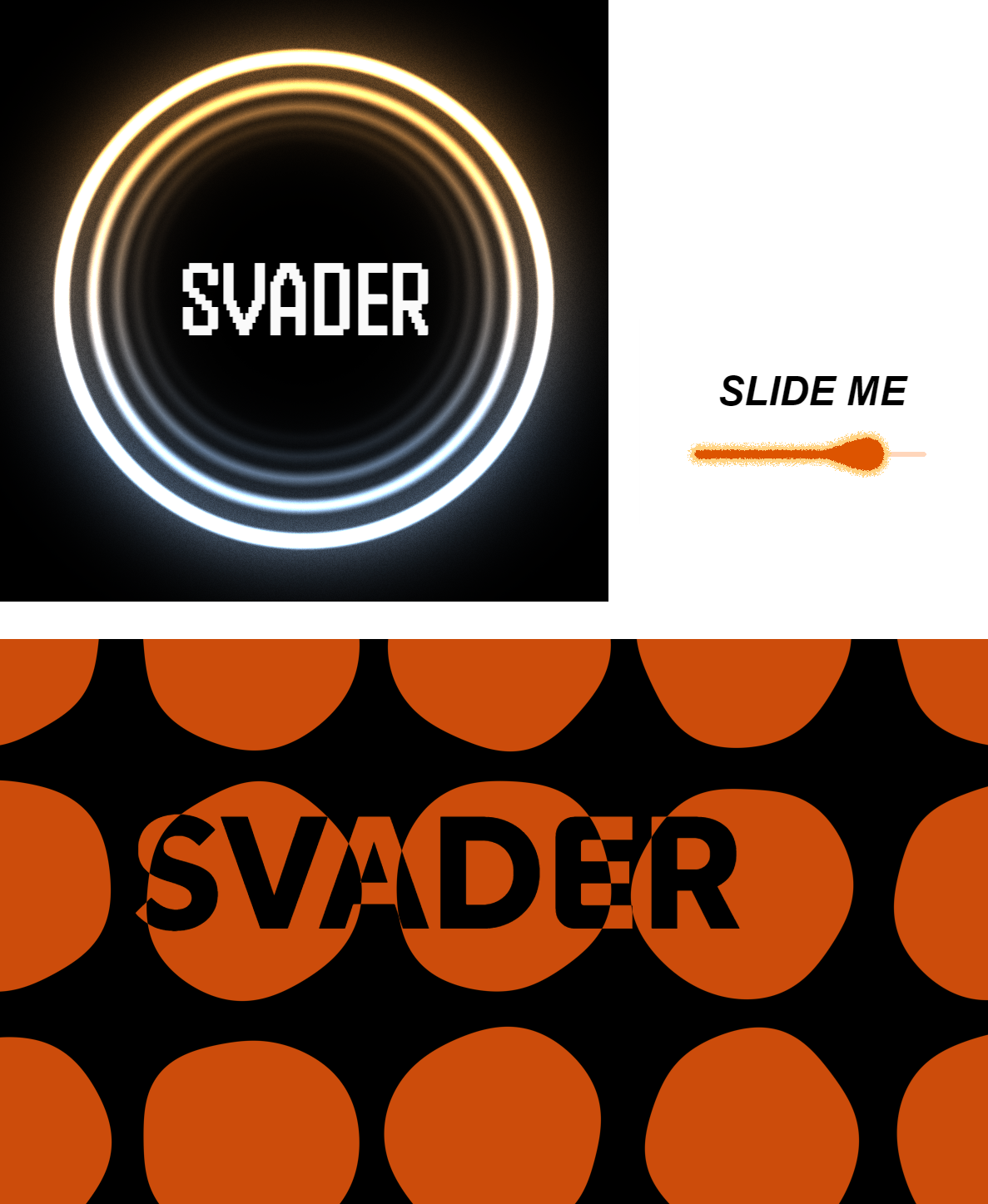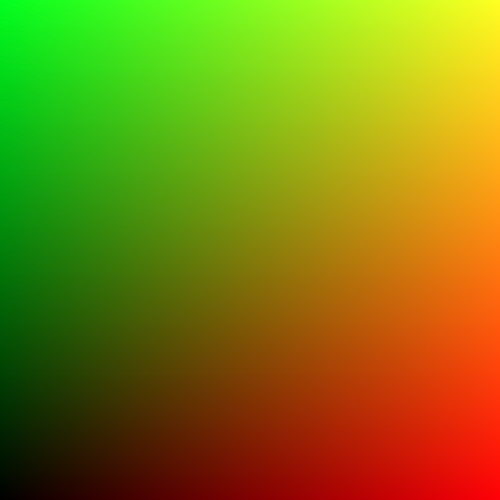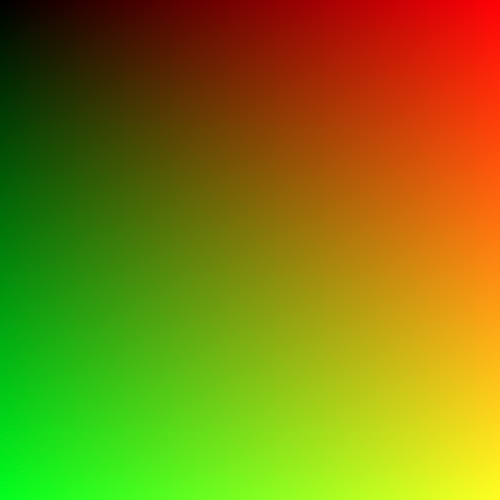
Create GPU-rendered Svelte components with WebGL and WebGPU fragment shaders.
Supports Svelte 4 and Svelte 5.
In short, a fragment shader can be written as a program that takes the coordinates of a pixel on the screen and returns the color that this pixel should have. This program can be executed on the GPU, ensuring massive parallelism and speed.
To learn more about how to write fragment shaders, check out The Book of Shaders.
The following is a collection of examples all made using Svader. The live version of all of these can be previewed on svader.vercel.app,
and the source code can be found in the src/routes/ directory.
# npm
npm i -D svader
# pnpm
pnpm i -D svader
# Bun
bun i -D svader
# Yarn
yarn add -D svaderTo use a fragment shader component, you first need to decide whether to use WebGL or WebGPU. If you're unsure about what to use, see the WebGL vs. WebGPU section.
The following is a minimal example of a WebGL fragment shader component.
<script>
import { WebGlShader } from "svader";
const shaderCode = `#version 300 es
precision highp float;
out vec4 fragColor;
uniform vec2 u_resolution;
uniform vec2 u_offset;
void main() {
vec2 pos = gl_FragCoord.xy + u_offset;
vec2 st = pos / u_resolution;
fragColor = vec4(st, 0.0, 1.0);
}
`;
</script>
<WebGlShader
width="500px"
height="500px"
code={shaderCode}
parameters={[
{
name: "u_resolution",
value: "resolution",
},
{
name: "u_offset",
value: "offset",
},
]}
>
<div class="fallback">WebGL not supported in this environment.</div>
</WebGlShader>This produces the following output:
Here, the shaderCode variable is a string containing the GLES shader code.
For simplicity, this is stored as a string, but it would typically be stored in a separate myShader.frag file.
When loading the shader from a file, it might be useful to know that the code property accepts both a string and a Promise<string>.
What this code does is:
- Add the given
u_offsetuniform to the 2D coordinates of the pixel given bygl_FragCoord.xy. - Divide the resulting coordinates entrywise by the
u_resolutionuniform to normalize the coordinates between 0 and 1. - Return the normalized coordinates as the color of the pixel, such that the
xcoordinate becomes the red channel and theycoordinate becomes the green channel. The blue channel is always set to 0, and the alpha (opacity) channel is always set to 1 (fully opaque).
In GLES, uniforms are inputs to the function, that are the same for every pixel on the screen.
These need to be passed in via the parameters property of the <WebGlShader> component.
In this case, we need to pass in two uniforms: u_resolution and u_offset.
Since these specific parameters are very commonly used, they are specially implemented in Svader
such that the value property of each parameter can simply be set to "resolution" and "offset" respectively.
Lastly, the <WebGlShader> component accepts a fallback slot, which is rendered when the browser cannot render the shader.
The parameters property is an array of objects with the following properties:
-
name: The name of the uniform parameter, e.g."my_uniform". This must match the name of the parameter in the shader code. -
type: The type of the uniform parameter as it is written in the shader code, e.g."float". If thevalueproperty is a built-in value, such as"resolution", thetypewill be determined automatically and should not be set. -
value: The value of the uniform parameter, or a string specifying a built-in value. If not a built-in value, the type of this property must correspond to thetypeproperty, such that:float,int,uintis anumber,vecN,ivecN,uvecNis anumber[]with a length ofN, e.g.vec2->[1.2, 3.4].matNis anumber[]with a length ofN * N, e.g.mat2->[1, 2, 3, 4].
Some types of uniforms are used very often. These are implemented in Svader itself, and referred to as built-in values.
To use these, the value property of the parameter object must be set to a string matching one of the following:
-
"resolution": Avec2of the canvas width and height in physical device pixels. -
"scale": Afloatof the ratio between CSS pixels and physical device pixels, i.e. zoom level. For example, if the browser has been zoomed to 150%, thescaleparameter will be1.5. -
"time": Afloatof the current time in seconds. NOTE: Passing this parameter to the shader will cause it to rerender every frame. -
"offset": Avec2to be added to thegl_FragCoord.xyof the fragment shader. Sometimes the size of the canvas is limited by hardware. To compensate for this, Svader creates a virtual canvas with a smaller cutout shifting around to cover the screen. The"resolution"parameter is automatically adjusted to match the size of this virtual canvas, but for technical reasons, thegl_FragCoord.xycannot be adjusted from the outside. Therefore, the"offset"parameter is provided to be manually added to these coordinates.
The following is a minimal example of a WebGPU fragment shader component.
<script>
import { WebGpuShader } from "svader";
const shaderCode = `
@group(0) @binding(0) var<uniform> resolution: vec2f;
@group(0) @binding(1) var<uniform> offset: vec2f;
@fragment
fn main(@builtin(position) raw_pos: vec4f) -> @location(0) vec4f {
let pos = raw_pos.xy + offset;
let st = pos / resolution;
return vec4f(st, 0.0, 1.0);
}
`;
</script>
<WebGpuShader
width="500px"
height="500px"
code={shaderCode}
parameters={[
{
label: "Resolution",
binding: 0,
value: "resolution",
},
{
label: "Offset",
binding: 1,
value: "offset",
},
]}
>
<div class="fallback">WebGPU not supported in this environment.</div>
</WebGpuShader>This produces the following output:
Here, the shaderCode variable is a string containing the WGSL shader code.
For simplicity, this is stored as a string, but it would typically be stored in a separate myShader.wgsl file.
When loading the shader from a file, it might be useful to know that the code property accepts both a string and a Promise<string>.
What this code does is:
- Add the given
offsetuniform variable to the 2D coordinates of the pixel given byraw_pos.xy. - Divide the resulting coordinates entrywise by the
resolutionuniform to normalize the coordinates between 0 and 1. - Return the normalized coordinates as the color of the pixel, such that the
xcoordinate becomes the red channel and theycoordinate becomes the green channel. The blue channel is always set to 0, and the alpha (opacity) channel is always set to 1 (fully opaque).
In WGSL, these var<uniform>s are the primary way to pass in parameters to the shader.
These need to be passed in via the parameters property of the <WebGpuShader> component.
In this case, we need to pass in two uniforms: resolution and offset.
Since these specific parameters are very commonly used, they are specially implemented in Svader
such that the value property of each parameter can simply be set to "resolution" and "offset" respectively.
Lastly, the <WebGpuShader> component accepts a fallback slot, which is rendered when the browser cannot render the shader.
The parameters property is an array of objects with the following properties:
-
label: The name of the parameter to be used for debugging. This does not have to correspond to the name of the parameter in the shader code. -
binding: An integer used to match the parameter to the variable in the shader code. This has to match thebindingproperty of the parameter in the shader code, e.g. for the variable declaration@group(0) @binding(42) var<uniform> my_variable: f32;
the
bindingproperty should be42. -
value: The value of the parameter, or a string specifying a built-in value. If not a built-in value, this parameter should be anArrayBuffer/ArrayBufferView. For example, to pass in a number to anf32parameter, it can be constructed likenew Float32Array([myNumberValue]). -
storage: [Optional - defaults tofalse] Whether the parameter is a storage variable rather than a uniform variable. This has to match the declaration in the shader code, e.g. for the variable declaration@group(0) @binding(0) var<uniform> my_variable: f32;
the
storageproperty should befalseor omitted, and for@group(0) @binding(0) var<storage, read> my_variable: f32;
it should be
true. Note that Svader currently only supportsvar<storage, read>and notvar<storage, read_write>.
Some types of inputs are used very often. These are implemented in Svader itself, and referred to as built-in values.
To use these, the value property of the parameter object must be set to a string matching one of the following:
-
"resolution": Avec2fof the canvas width and height in physical device pixels. -
"scale": Anf32of the ratio between CSS pixels and physical device pixels, i.e. zoom level. For example, if the browser has been zoomed to 150%, thescaleparameter will be1.5. -
"time": Anf32of the current time in seconds. NOTE: Passing this parameter to the shader will cause it to rerender every frame. -
"offset": Avec2fto be added to the@builtin(position)of the fragment shader. Sometimes the size of the canvas is limited by hardware. To compensate for this, Svader creates a virtual canvas with a smaller cutout shifting around to cover the screen. The"resolution"parameter is automatically adjusted to match the size of this virtual canvas, but for technical reasons, the@builtin(position)cannot be adjusted from the outside. Therefore, the"offset"parameter is provided to be manually added to these coordinates.
For practical applications, default to using WebGL.
WebGL and WebGPU are both rendering APIs that allow web applications to render GPU-accelerated graphics.
WebGL is the older of the two and is supported by all modern browsers.
WebGPU is still in the experimental stage and is only supported in a few browsers. However, it supports certain features that WebGL does not. For example, as of writing, WebGL in Google Chrome only supports having 8 canvases active in the document at once, while WebGPU supports a practically unlimited number.
Svader is licensed under the MIT License.


